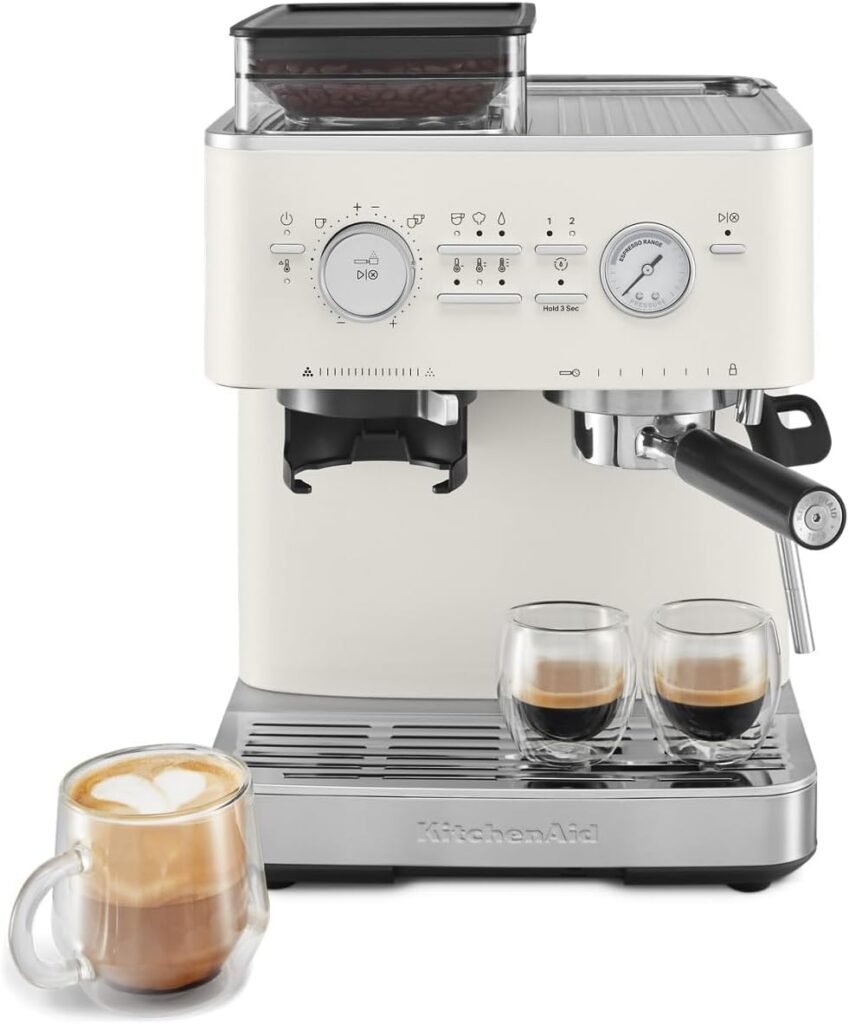I still remember my first attempt at brewing espresso. The result was far from perfect, but it sparked a journey to understand the intricacies of this concentrated coffee drink.
Espresso is the ultimate expression of what roasted coffee has to offer. It’s a brewing method that uses high pressure to extract intense flavors from finely ground coffee beans, resulting in a rich and complex shot.
As a beginner, navigating the world of espresso can be daunting, but with practice and patience, anyone can master the art of brewing the perfect shot.
Key Takeaways
- Understand the basics of espresso and its brewing method.
- Learn how to select the right equipment for brewing coffee.
- Discover the importance of using finely ground coffee beans.
- Troubleshoot common problems encountered while brewing espresso.
- Develop the skills to brew a perfect shot of espresso.
Understanding Espresso: More Than Just Strong Coffee
Espresso is often misunderstood as just a strong version of coffee, but it’s much more complex. At its core, espresso is a carefully crafted beverage that requires precision and attention to detail.
What Makes Espresso Different
Espresso stands out from other coffee brewing methods due to its unique combination of high pressure, high temperature water, and finely ground coffee. This process results in a concentrated drink that’s far bolder and more flavorful than regular coffee. The key differences lie in the pressure, concentration, and extraction time, which I’ll explore in more detail.
| Brewing Method | Pressure | Extraction Time | Concentration |
|---|---|---|---|
| Espresso | High | 25 seconds | High |
| Drip Coffee | Low | 5-10 minutes | Low |
| French Press | Low | 4-5 minutes | Medium |
The Science Behind Extraction
The science behind espresso extraction is fascinating. When high pressure and high temperature water pass through a puck of finely ground coffee, it extracts the complex flavors, resulting in a rich and concentrated beverage. The golden rule of espresso is to pour 2 ounces in a 25-second period, which is known as the extraction time. This precise balance of variables is what sets espresso apart from other coffee brewing methods.
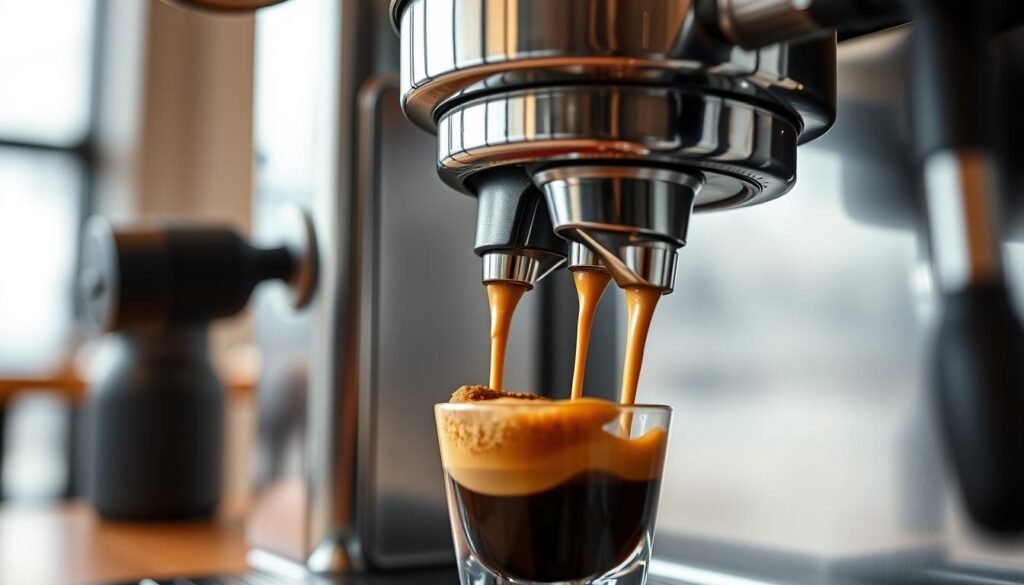
Understanding the science behind extraction is crucial to appreciating the art of making great espresso. By controlling variables like pressure, temperature, and extraction time, baristas can craft a perfect shot every time.
Essential Equipment for Espresso for Beginners
Embarking on your espresso journey requires the right equipment to bring out the best flavors. As a beginner, understanding the essential tools will help you brew high-quality espresso consistently.
Espresso Machines: Types and Features
When it comes to espresso machines, the type of boiler is a critical factor. You’ll find single boilers, heat exchangers, and dual boilers. Single boilers are simpler and more affordable, while dual boilers offer more flexibility and higher quality. For beginners, a semi-automatic espresso machine is a great starting point, as it allows for manual control over brewing.
The main difference between these machines lies in their ability to maintain temperature and pressure. A top-class espresso machine can produce excellent shots, but it’s only as good as the grinder that feeds it.
Grinders: The Unsung Heroes
A grinder is often considered more important than the espresso machine itself, as it directly affects the quality of the grind. Burr grinders are preferred for their consistency and ability to produce a precise grind size. Investing in a quality coffee grinders is crucial for achieving the perfect shot.
The grind size and distribution significantly impact the flavor of your espresso. A good grinder ensures that you’re getting the best out of your coffee beans.
Additional Tools and Accessories
In addition to an espresso machine and grinder, other essential tools include tampers, distribution tools, scales, and knock boxes. These accessories help ensure that your espresso is brewed to perfection. A tamper, for instance, is used to compress the coffee grounds in the portafilter, while a scale ensures accurate measurement.
By investing in these quality tools, you’ll be well on your way to brewing exceptional espresso at home.
Selecting the Perfect Coffee Beans
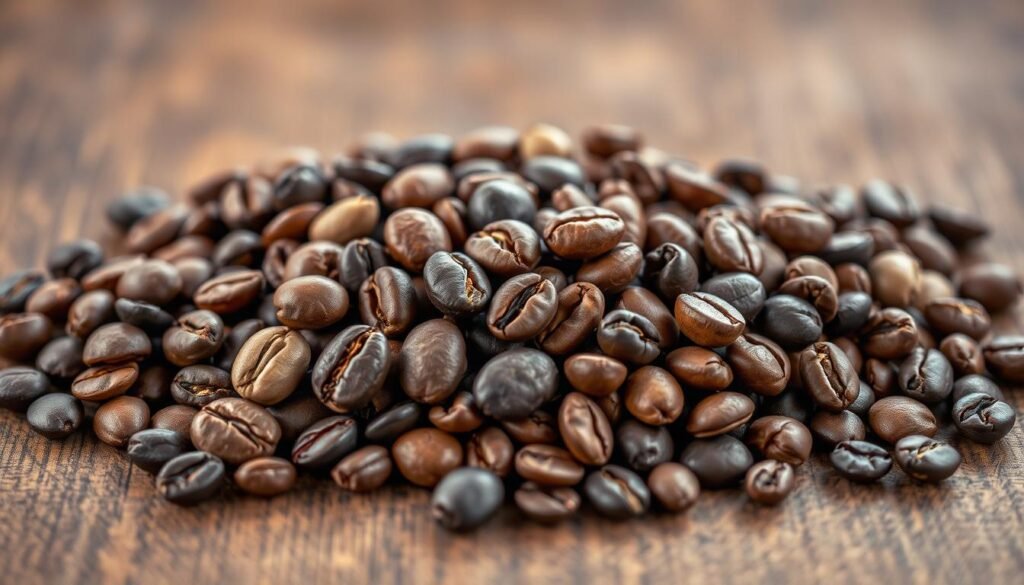
To brew an exceptional espresso, you need to start with the best coffee beans. Even with great gear, you can’t pull a good espresso if you don’t start with good coffee. Although traditionally espresso is made with a darker roast, picking out a coffee bean strictly marketed as “espresso” isn’t necessary.
Arabica vs. Robusta: Understanding Bean Types
There are two major bean types: Coffea Arabica (Arabica) and Coffea Caneophora (Robusta). Arabica beans are seen as a sign of quality beans and blends. Arabica beans offer a nuanced flavor and aroma, while Robusta beans have a bolder, harsher taste and higher caffeine content.
Roast Levels and Their Impact on Flavor
The roast level of your coffee beans significantly impacts the flavor of your espresso. Lighter roasts preserve more of the coffee’s natural acidity and flavor notes, while darker roasts bring out a richer, deeper flavor. Traditional Italian espresso typically uses darker roasts for their characteristic bold flavor.
Freshness Matters: Storage and Shelf Life
Freshness is crucial for optimal flavor. Coffee beans are best consumed within a few weeks of roasting. To maintain freshness, store your beans in an airtight container, away from light and heat. This ensures your espresso remains vibrant and full of flavor.
By understanding the differences between Arabica and Robusta, experimenting with roast levels, and maintaining the freshness of your coffee beans, you can significantly enhance your espresso experience.
The Art of Grinding and Dosing
To brew exceptional espresso, understanding the nuances of grinding and dosing is essential. The quality of your espresso is heavily dependent on these two factors, which work in tandem to produce the perfect shot.
Finding the Right Grind Size
The grind size of your coffee beans is a critical variable in espresso preparation, affecting the extraction rate, flavor balance, and shot timing. Ideally, the grind size should be slightly finer than granulated sugar.A grind that is too fine can lead to over-extraction and a bitter taste, while a grind that is too coarse results in under-extraction and a weak flavor.To find the optimal grind size, look for visual and tactile cues, such as the coffee’s texture and how it feels between your fingers.
Measuring Your Dose: Weight vs. Volume
For a double shot of espresso, a standard dose is between 13 and 18 grams of coffee. I found that for the Infuser, 15 grams was a good starting point.Measuring your dose by weight is more accurate than by volume, as it accounts for the density of the coffee beans.Using a scale to weigh your coffee ensures consistency in your shots, which is crucial for achieving a balanced flavor.
Distribution Techniques for Even Extraction
Once you’ve ground and dosed your coffee, you’ll have a mound that needs to be evenly distributed in the portafilter.Proper distribution is key to preventing channeling and ensuring that water flows through the coffee puck uniformly.Techniques such as gently tapping the portafilter or using a distribution tool can help achieve an even extraction. A well-distributed coffee puck is essential for a smooth, balanced shot of espresso.
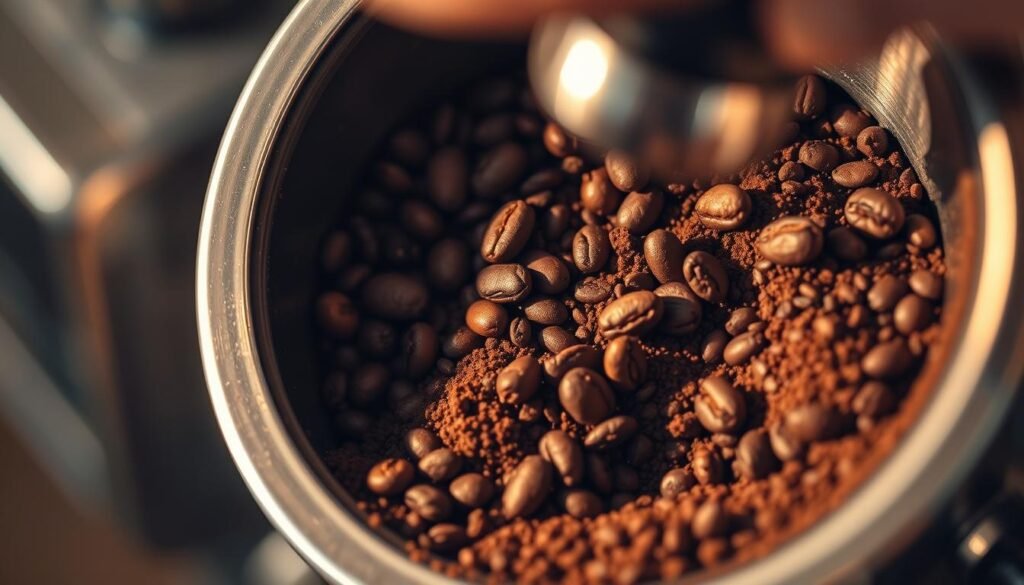
- The ideal grind size for espresso is slightly finer than granulated sugar.
- Measuring coffee by weight is more accurate than by volume.
- Even distribution of the coffee puck is crucial for preventing channeling.
Mastering the Perfect Tamp
The art of tamping is often overlooked, but it’s a critical component of brewing excellent espresso. Tamping is integral to making fine espresso, as it creates a uniform surface through which brew water can flow evenly.
Proper Tamping Technique
To achieve a perfect tamp, you need to apply a strong but measured amount of pressure to the coffee grounds on a level surface. This ensures an even tamp and prevents channeling. I recommend standing with your feet shoulder-width apart and your body balanced evenly over the portafilter. Hold the tamper with a firm grip, and bring it down to the coffee grounds with a smooth, level motion.
A proper tamping technique involves distributing the coffee grounds evenly and then tamping them with a consistent amount of pressure. The goal is to create a uniform, compressed bed of coffee that allows for even water flow during extraction.
Common Tamping Mistakes to Avoid
Beginners often make mistakes such as applying uneven pressure, using excessive force, or twisting the tamper. These mistakes can lead to channeling, over-extraction, or under-extraction, ultimately affecting the taste of your espresso. To avoid these issues, focus on developing a consistent tamping technique.
| Tamping Mistake | Effect on Espresso | Correction |
|---|---|---|
| Uneven Pressure | Channeling, leading to over-extraction | Ensure level surface and balanced body position |
| Excessive Force | Over-extraction, resulting in bitter taste | Apply measured pressure, around 30 pounds |
| Twisting the Tamper | Uneven extraction, affecting flavor | Use a smooth, level motion when tamping |
Pulling Your First Shot: Step-by-Step Guide
Pulling your first espresso shot is an exciting milestone in your coffee journey. With the right preparation and understanding of the process, you’ll be on your way to creating exceptional espresso.
Preparing Your Machine
Before you start brewing, ensure your espresso machine is ready. This involves stabilizing the temperature and preheating the portafilter and cups. Proper preparation is key to achieving a great shot. I recommend running a blank shot through the machine to heat it up and clear any residual water.
Preheating is crucial as it ensures that the espresso machine and portafilter are at the optimal temperature for brewing.
The Brewing Process
Once you’ve tamped down your coffee, it’s time to lock the portafilter into the brew head. Begin brewing, aiming for a brew time of about 25 seconds for your shot. As the espresso flows, observe its color and flow rate. The ideal shot should have a rich crema and a caramel brown color with lighter blond tones.
- Monitor the flow rate to ensure it’s neither too fast nor too slow.
- Adjust your grind setting if the shot is too light or too dark.
- Pay attention to the volume of the shot to achieve the perfect balance.
Visual Cues for a Good Extraction
A properly pulled shot of espresso should display a swirled or speckled mix of colors. If the shot is uniformly light, it may taste sour, indicating a need for a finer grind setting. Conversely, a shot that’s too dark may be over-extracted and bitter.
By paying attention to these visual cues, you can adjust your brewing technique to achieve a perfectly balanced shot.
Understanding Extraction Variables
Mastering espresso extraction involves understanding several key variables that impact the final flavor. Achieving a perfect shot requires balancing multiple factors that influence the extraction process.
The Golden Ratio: Time, Volume, and Dose
The concept of the “golden ratio” in espresso preparation is crucial for balanced extraction. It involves the interaction of time, volume, and dose to create a harmonious shot. The Specialty Coffee Association recommends a brewing time of around 25 seconds for 2 ounces of espresso. If the shot extracts too quickly, the grind may be too coarse; if it’s too slow, the grind may be too fine. Adjusting the grind size based on the extraction time is essential for achieving the perfect balance.
The ratio of coffee input to espresso output, known as the brew ratio, is another critical factor. A traditional espresso ratio is often around 1:2. Adjusting this ratio can significantly affect the flavor profile of your espresso.
| Brew Ratio | Description | Flavor Profile |
|---|---|---|
| 1:1.5 | Strong and concentrated | Bold, intense flavors |
| 1:2 | Traditional espresso ratio | Balanced, rich flavors |
| 1:3 | Milder and more voluminous | Smoother, nuanced flavors |
Temperature and Pressure Considerations
Temperature is a vital factor in espresso extraction. The ideal brewing temperature ranges between 195°F and 205°F, according to the Specialty Coffee Association. This should result in a shot that is around 160-165°F in the cup. Ensuring the optimal temperature is crucial for flavor development.
Pressure is another key variable, particularly in advanced machines that allow for pressure profiling. Adjusting the pressure during extraction can manipulate the flavor profile, allowing for a more customized espresso experience.
Milk Frothing Fundamentals
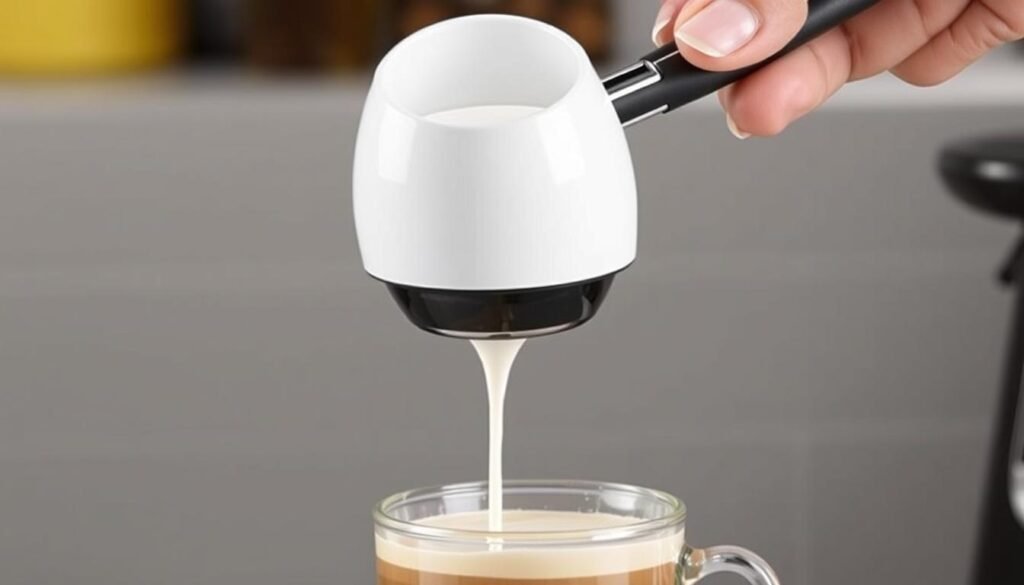
To take your espresso experience to the next level, understanding milk frothing fundamentals is key. Frothing milk is an art that requires practice, but with the right technique, you can create a variety of delicious espresso-based drinks.
The process involves steaming milk to the right temperature and texture, which can be achieved with a good quality milk frother. For beginners, it’s essential to start with the basics, such as understanding the type of milk to use and how to handle the steaming wand.
Steaming Techniques for Different Drinks
Different espresso-based drinks require different steaming techniques. For instance, lattes require silky microfoam, while cappuccinos need a stiffer foam. To achieve this, one must master the frothing technique, including wand positioning and pitcher angle.
For a latte, the nozzle should be just below the surface of the milk, creating a quiet hiss that produces fine, velvety bubbles. In contrast, cappuccinos require a slightly different approach to create the desired stiffness in the foam.
Alternative Milks and Their Frothing Properties
Not everyone can or wants to consume dairy milk, making alternative milks a popular choice. Oat, almond, and soy milks are common alternatives, each with its own frothing properties. Understanding these properties is crucial for achieving the desired texture in your espresso-based drinks.
For example, oat milk tends to froth well, creating a creamy texture, while almond milk can be more challenging to froth due to its low fat content. Experimenting with different alternative milks and adjusting your steaming technique accordingly can help you find the perfect match for your taste preferences.
Troubleshooting Common Espresso Problems
As you embark on your espresso journey, troubleshooting common problems is crucial for achieving the perfect shot. Even with the right equipment and technique, issues can arise that affect the quality of your espresso. Understanding how to diagnose and resolve these problems is key to consistent performance.
Diagnosing Extraction Issues
Diagnosing extraction issues is the first step in troubleshooting your espresso. If your shot is pulling too quickly, it may be under-extracted and taste sour. Conversely, a shot that takes too long to pull may be over-extracted and bitter. Adjusting the grind size of your coffee beans is often the solution to these problems. For instance, if your shot is too fast, a finer grind can slow down the extraction, while a coarser grind can speed it up if it’s too slow. Additionally, the color and texture of the espresso can provide visual cues; a uniformly light-colored shot may indicate under-extraction, suggesting the need for a finer grind.
Machine Maintenance Tips
Regular maintenance of your espresso machine is vital for consistent performance and longevity. Cleaning and drying the portafilter after each use prevents coffee buildup, which can affect the taste of your shots. Regularly backflushing your machine helps remove old coffee oils and residue, while descaling prevents mineral buildup that can damage your machine over time. Moreover, cleaning the group head ensures that every shot is free from residual flavors. By following a routine maintenance schedule, you can prevent many common issues and ensure your machine continues to produce high-quality espresso.
Some key maintenance tasks include daily cleaning of the portafilter and group head, weekly backflushing, and regular descaling. By incorporating these tasks into your routine, you can avoid common problems such as channeling, uneven extraction, and machine malfunction, ultimately leading to better-tasting shots and a longer machine lifespan.
Conclusion: Your Journey to Espresso Mastery
The art of crafting the perfect espresso shot is a journey that requires patience and practice. To achieve espresso mastery, one must balance the Italian “four Ms”: mano (hand), macchina (machine), macinadosatore (grinder), and miscela (blend). By understanding and mastering these elements, you’ll be well on your way to brewing great coffee at home. Continue your education through resources like books and online communities. With the right approach, making great espresso is achievable, and the journey itself is rewarding.


